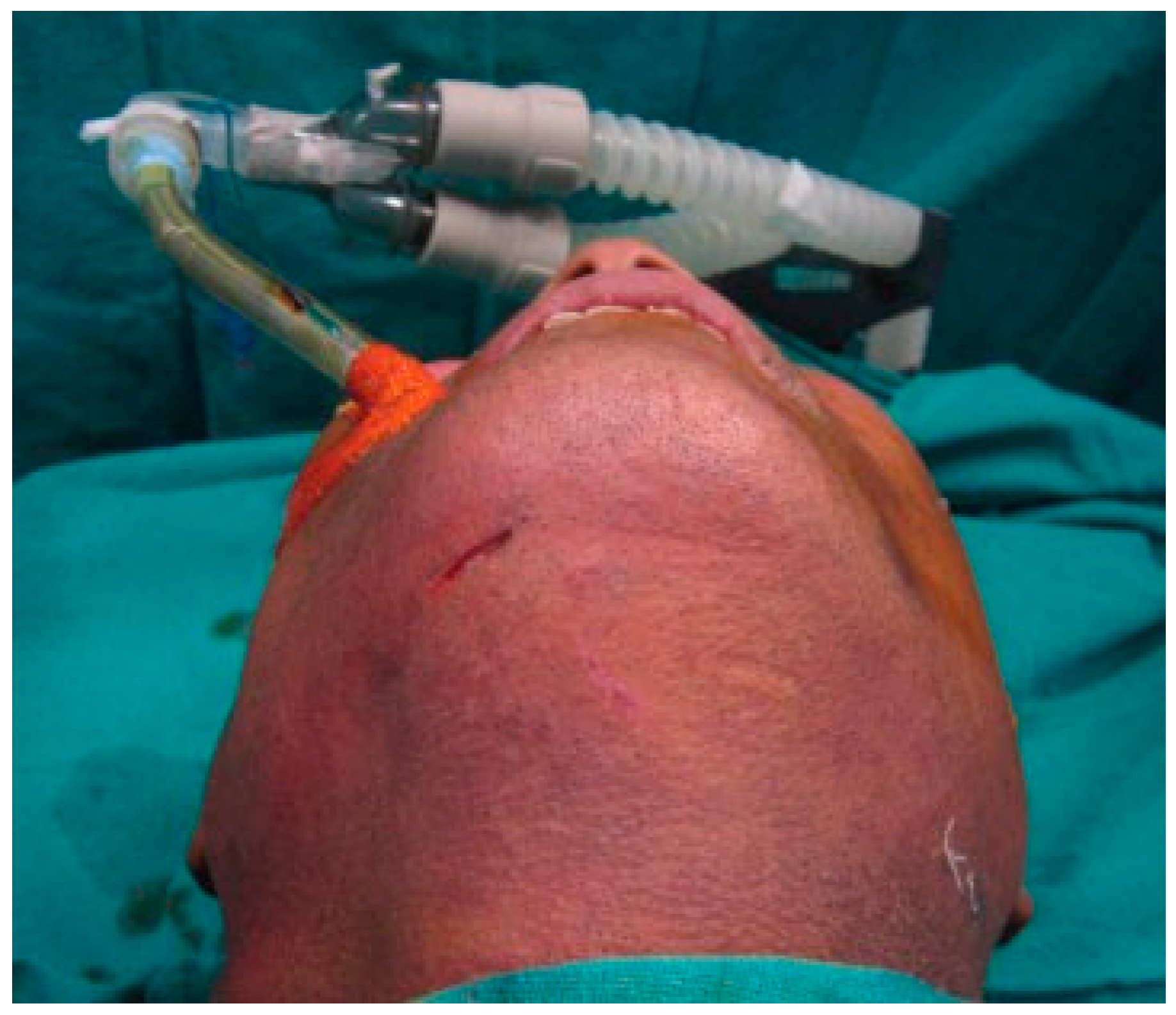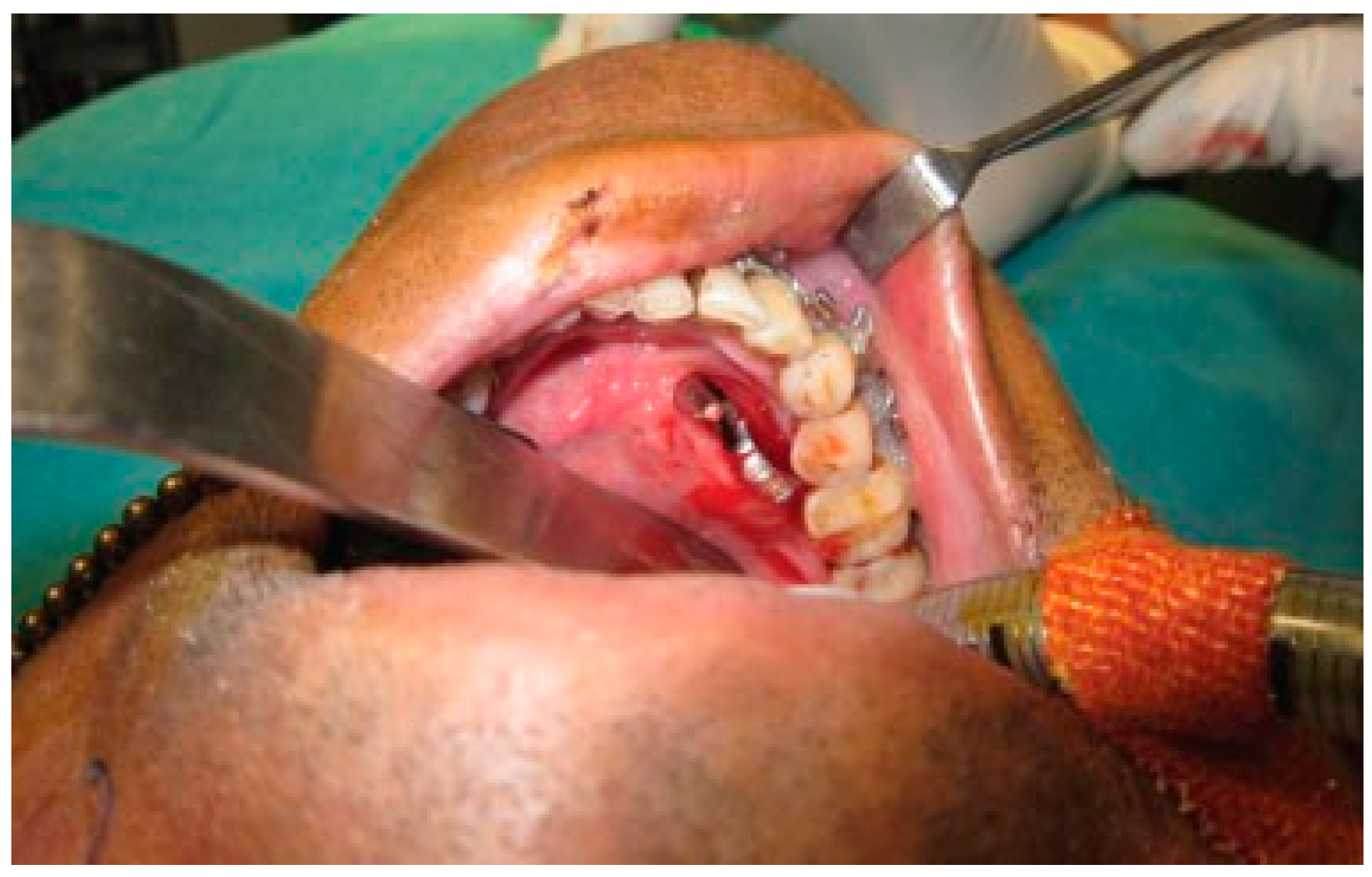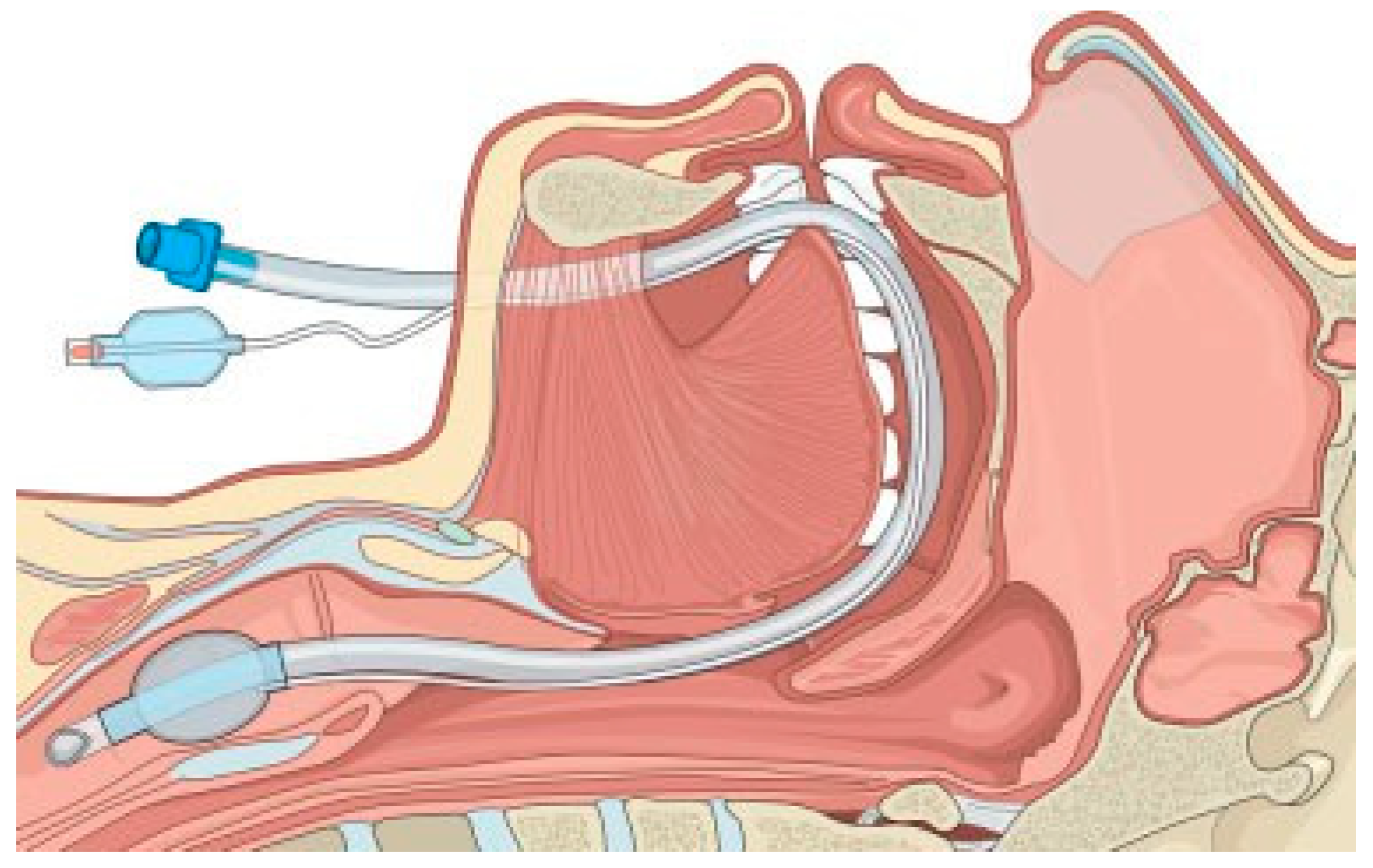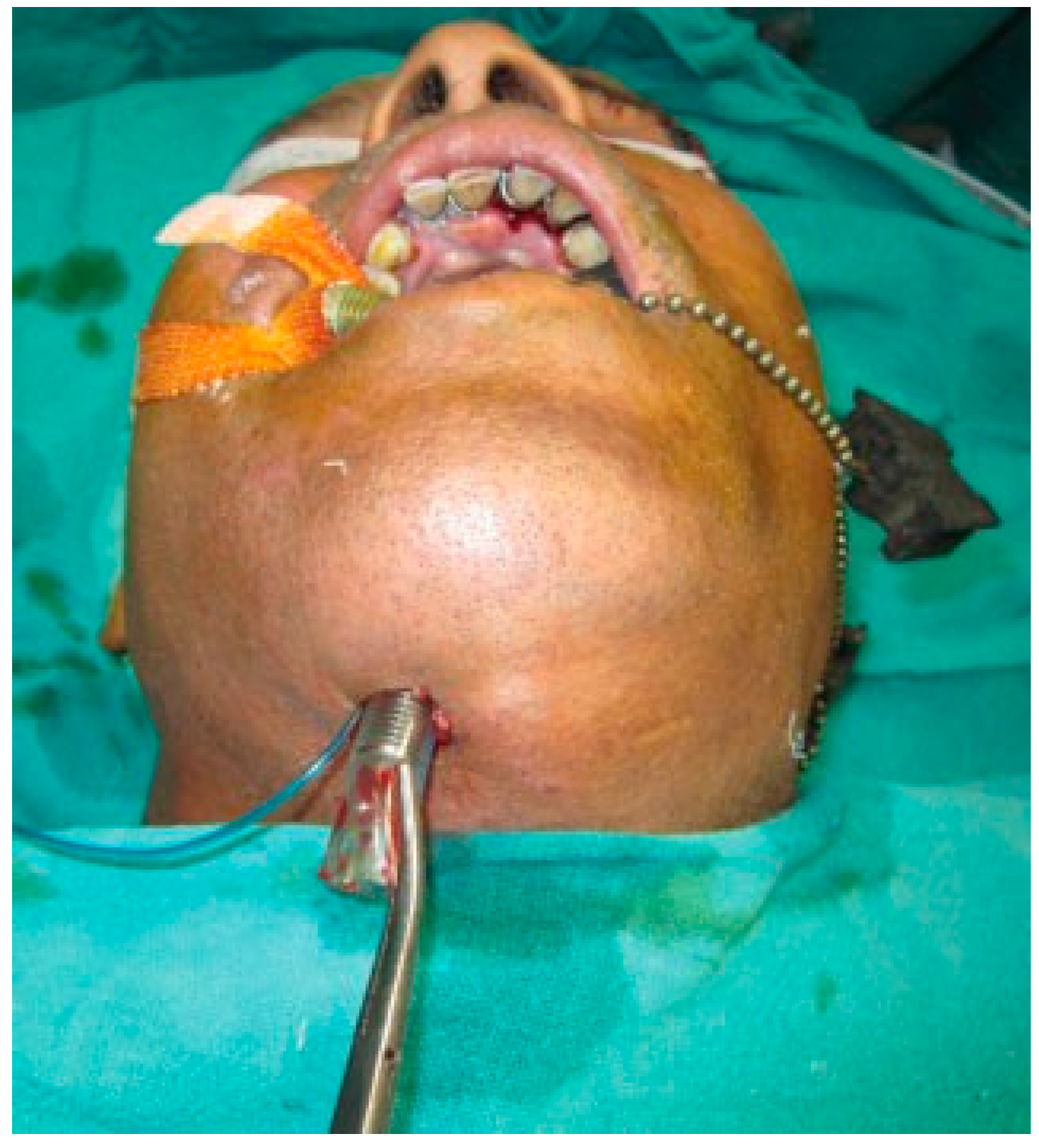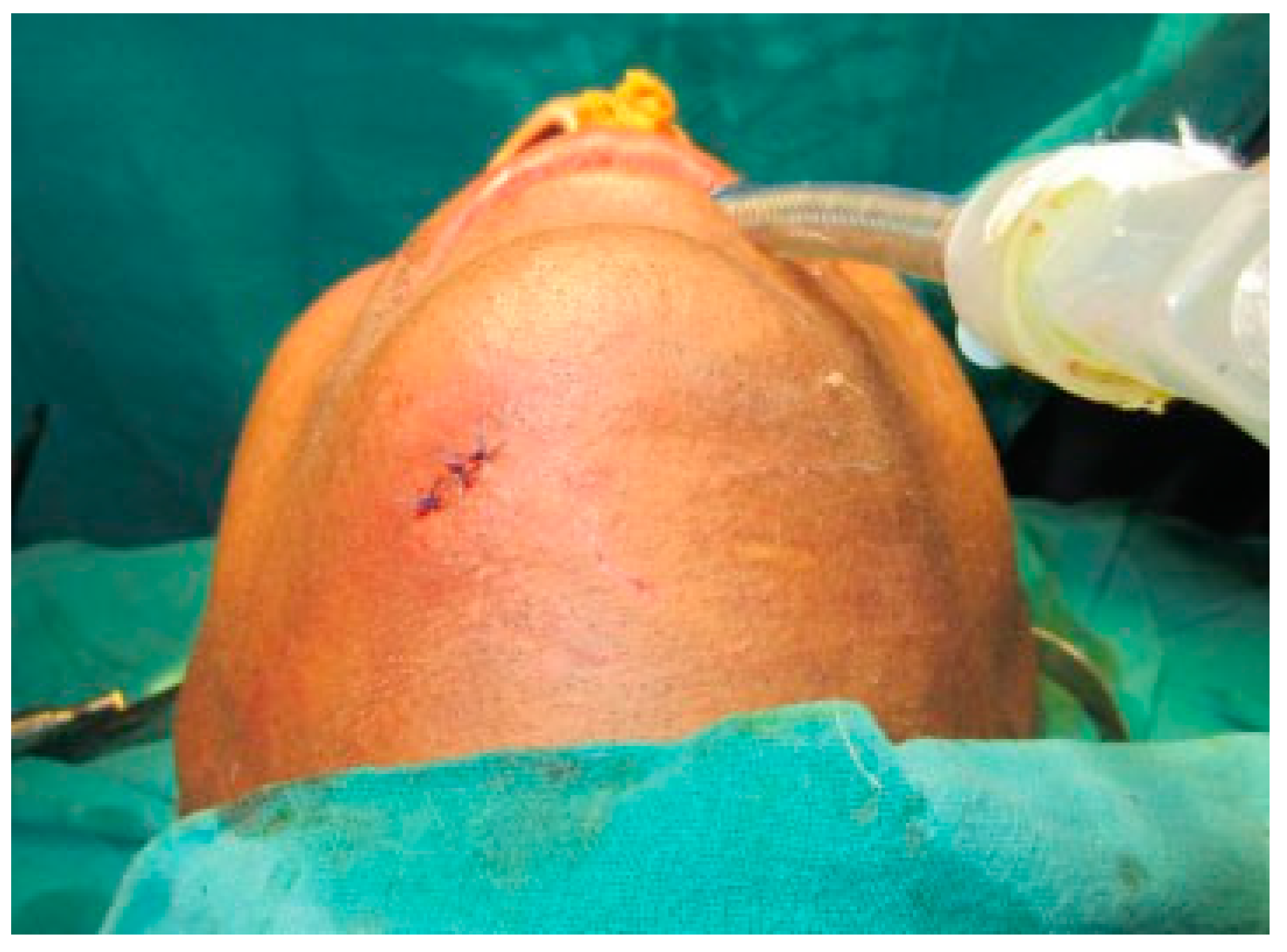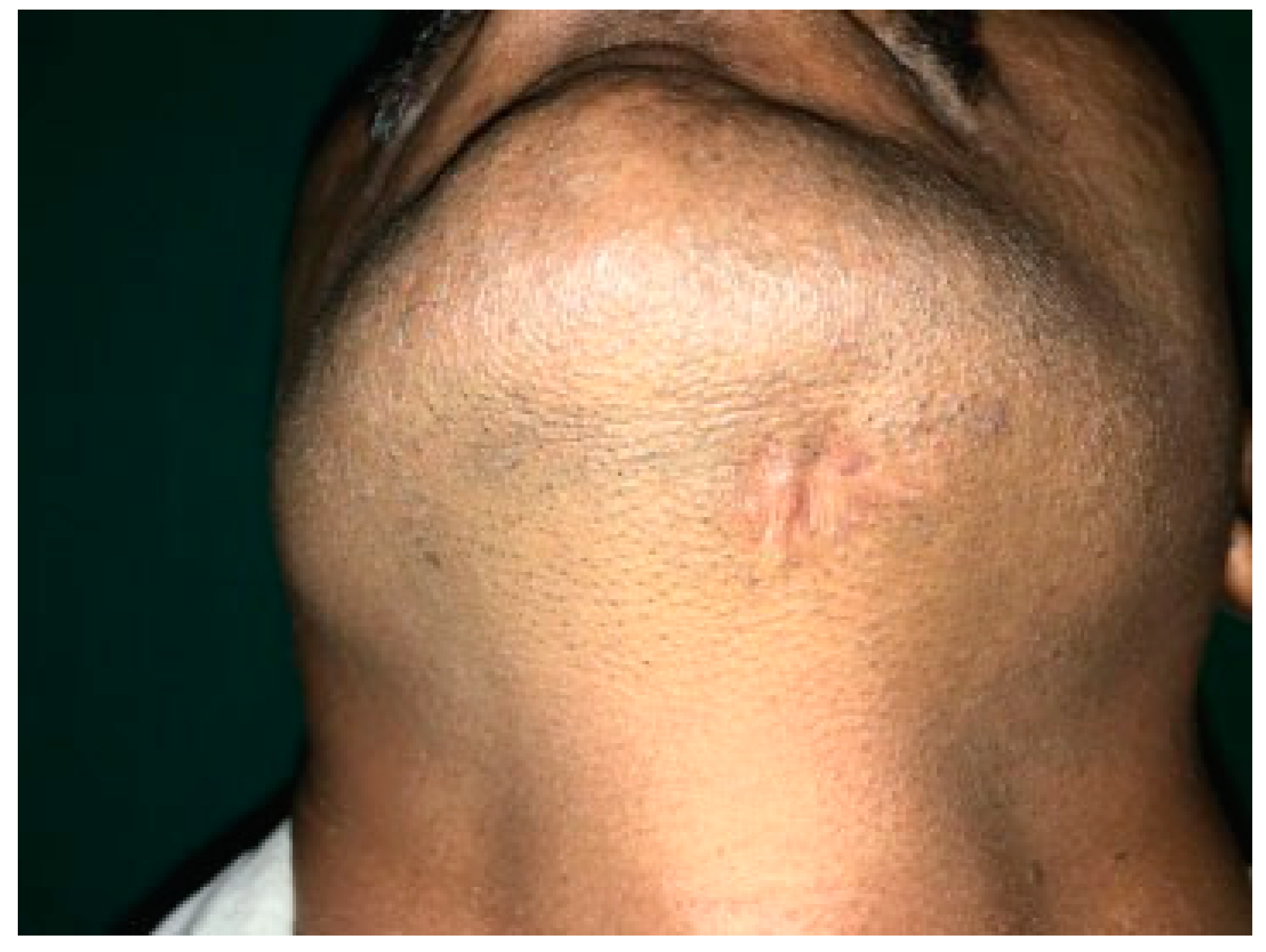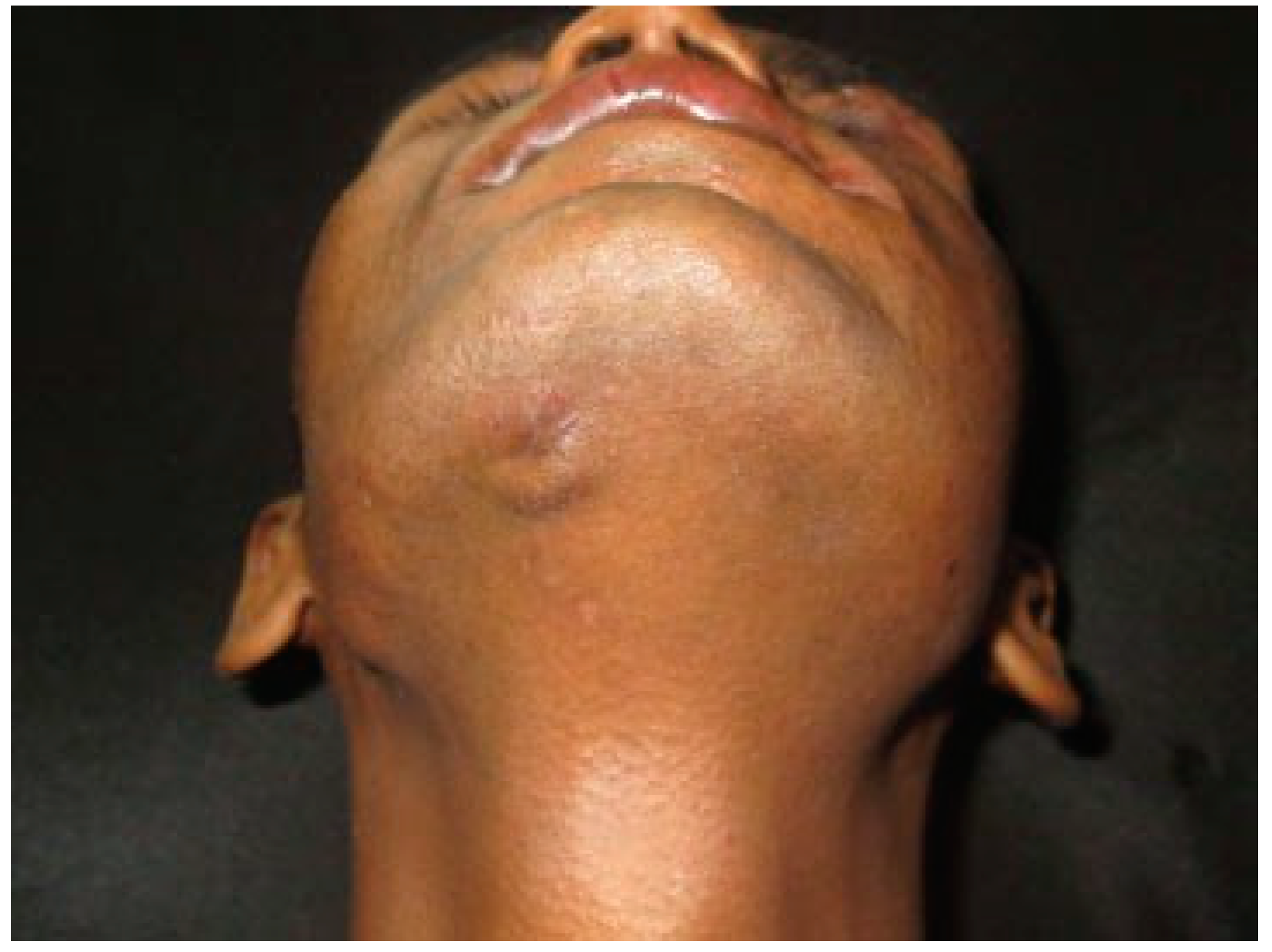Basically, there are two standard surgical approaches to TMI, namely, paramedian and median approach. We have practiced the paramedian/lateral/(anterior submandibular) approach in this study, as it avoids vital structures in the floor of the mouth. We hypothesize that lateral/paramedian approach for TMI is a quick, safe, and efficient method of securing airway in perioperative period for elective surgical management of midfacial and CMF. We aim to deliberate our experience with this technique within a prospective study of 206 cases of CMF.
Methodology
A thorough preanesthetic check-up was done a day preceding the elective surgery. Preoperative intravenous antibiotics were administered approximately 2 h before surgery in all cases. In the operating room, ringers lactate intravenous drip was started in all the patients and premedications including injection ranitidine 50 mg, injection glycopyrrolate 0.2 mg, injection ondansetron 4.0 mg, injection midazolam 1 mg, and injection butorphanol 1.0 mg were administered. The patients were oxygenated with 100% oxygen for 5 min. Induction was done with propofol 2.0 mg/kg, and succinylcholine 1.5 mg/kg was given after adequate mask ventilation. Patients were intubated orally using an armored endotracheal tube (ETT) with detachable connector. To avoid damage to the facial vessels, we identified the inferior border of the jaw in the anterior submandibular area. The area of incision was located at approximately one-third of the distance from symphysis to the angle of mandible just medial to its lower border [
8]. (
Figure 1). This area corresponds to canine– premolar teeth area of the mandible. The side to get the ETT across the floor of mouth was chosen away from fractured mandible if present.
Before intubation, the universal connector of the armored tube was separated with a hemostat and reattached so that it can be separated rapidly from the tube while pulling the tube extraorally. Using an aseptic technique, the skin of the neck, lower face, and the end of the tracheal tube were cleaned with an appropriate antiseptic solution. A 1.5-cm skin incision was made parallel to the inferior border of the mandible in the anterior submandibular area beside the midline. With the aid of curved hemostat, we bluntly dissected (subcutaneous tissue, platysma muscle, and mylohyoid muscle) until the floor of the mouth in the premolar area is reached. To avoid damage to the lingual nerve or the sublingual salivary glands and Wharton’s duct, at all time points, the path of dissection was kept closely as possible to the medial surface of the mandibular body in the premolar area supraperiosteally. The mucosa at the floor of the mouth was tended using a lingual retractor in the mouth to displace the Wharton’s duct medially. Then the mucous membrane of the floor of the mouth was penetrated (
Figure 2) to create an opening wide enough to facilitate passage of tube. This allowed the ETT to be drawn with ease.
Figure 1.
Incision at anterior submandibular region.
Figure 1.
Incision at anterior submandibular region.
Figure 2.
Penetration of floor of the mouth with curved artery hemostat.
Figure 2.
Penetration of floor of the mouth with curved artery hemostat.
Both incisions were connected by blunt dissection, progressing from outside to inside. The passage thus created was widened to achieve internal planes of the same size as skin incision. The patients then were ventilated with 100% oxygen for 3 min to increase apneic reserves and prevent desaturation during brief period of ventilatory interruption when the ETT is drawn across the floor of mouth (
Figure 3). Later, the pneumatic cuff of the armored ETT was deflated. The ETT was briefly disconnected from the breathing circuit and the universal connector was removed. First, the cuff and then the tube was exteriorized via the preformed tunnel (
Figure 4). The tube was then pulled out one numerical mark more than that noted at the corner of the mouth. The connector was reattached, the cuff was reinflated, and the tracheal tube was reconnected to the breathing circuit. The position of the tracheal tube was checked using capnography and chest auscultation. The tube was then secured to the skin of the anterior submandibular area by 3.0 silk suture (
Figure 5). All the procedures were performed by a single team.
Figure 3.
Sketch showing ETT drawn across floor of mouth.
Figure 3.
Sketch showing ETT drawn across floor of mouth.
Figure 4.
Exteriorization of oral endotracheal tube through preformed tunnel.
Figure 4.
Exteriorization of oral endotracheal tube through preformed tunnel.
Careful monitoring of hemodynamic parameters and oxygen saturation was done during the changeover period. A throat pack was inserted in all the cases. Anesthesia was maintained with oxygen (30%), nitrous oxide (70%), isoflurane (0.5–1.0%), and vecuronium bromide (0.08 mg/kg). At the conclusion of the procedure, the deflated pilot tube cuff and the tube were pulled back in the reverse order and the mucosal incision was sutured followed by skin in all the cases. The incisions were closed with a 4–0 monofilamentous suture extraorally (
Figure 6) and intraorally, using 3–0 polyglactin 910 suture. The extraoral sutured wound was covered with medicated occlusive dressing and secured with an elastic tape. Extraoral sutures were removed on sixth day postsurgically.
Figure 5.
Transmylohyoid endotracheal tube secured to skin at the anterior submandibular region.
Figure 5.
Transmylohyoid endotracheal tube secured to skin at the anterior submandibular region.
Figure 6.
Extraoral sutured wound.
Figure 6.
Extraoral sutured wound.
All patients were assessed intraoperatively and followed up postoperatively during hospitalization for wound-associated complications and consequently at 1 and 3 weeks and subsequently every month until the third month postoperatively. The surgical area was assessed by digitally compressing it for evidence of any collection and discharge. The scar was evaluated by a scoring system devised and tailored by the authors. Scars were evaluated dependingon thetype and color, which is scored as follows: types of the scar—(1) imperceptible/minimal scar, (2) thin and linear scar, (3) wide scar, and (4) hypertrophic/keloid scar; color of the scar—(1) imperceptible, (2) hypopigmented, (3) scar with normal skin color, and (4) hyperpigmented.
The safety of the procedure was defined as the ability of the procedure to be performed without any significant intra- or postoperative complications. The efficacy was defined as the ability of the TMI to provide a secure airway for the entire duration of the proposed procedure with no episodes of oxygen desaturation [
9].
Discussion
Craniomaxillofacial trauma or panfacial fractures are essentially defined as fractures that simultaneously involve the upper, middle, or lower face [
10]. In such circumstances, difficulty in accessing the airway is compounded by the presence of bleeding, blood clots, loose teeth, foreign body, prosthesis, displaced and impinging fracture fragments, and impending tissue edema. Airway management in such cases mandates a symbiotic relationship between anesthetist and the maxillofacial surgeon.
Figure 7.
Wide scar at the surgical site.
Figure 7.
Wide scar at the surgical site.
Figure 8.
Wide scar at the surgical site.
Figure 8.
Wide scar at the surgical site.
This study was pursued to evaluate the utility, safety, efficacy, time required for the procedure, and intra- and postoperative complications in a prospective manner at a single center over 8 years. Since its first description, the spectrum of its indications has broadened to orthognathic surgery [
5], corrective surgery for craniofacial anomalies [
11], and skull base access surgery [
12].
On peering the literature, we observed significant dearth of prospective studies reporting use of submental/TMI technique in craniomaxillofacial trauma. Including our previous reported study [
7] and the present study, there are only five studies [
12,
13,
14,
15,
16] reporting the efficacy in a prospective manner.
The authors are in agreement with Gadre and Kushte [
17] for aptly refining the term submental intubation to TMI, as the path of ETT spans across any area between mandibular molars on either side anterior to facial artery. In this study, we employed the port of surgical access in the lateral/paramedian region as described by Hernández Altemir6 and Stoll et al [
18]. restricting it to the anterior submandibular region [
19]. MacInnis and Baig [
20] proposed a midline approach for TMI. We are in agreement that midline approach can traumatize the Wharton ducts, interferes with attachment of the genioglossi and geniohyoid muscles [
21], and can cause injury to mandibular lingual perforating vessels, which are present in the midline in 98% of instances [
22], leading to bleeding and sublingual hematoma [
23].
The lateral/paramedian approach was endorsed by several authors [
7,
24,
25,
26,
27,
28]. The main advantage of anterior submandibular approach over the submental approach is that the tube passes through a shorter pathway without interfering with muscles except from the mylohyoid muscle. The risk of infection and formation of an abscess in the tunnel is consequently lower and the risk of damage to important structures such as the lingual nerve and the Wharton’s duct can be avoided as long as the tube passes in close contact with the medial surface of the mandible. Altemir et al. [
28] also emphasized this approach. According to them, the incision should be made in the paramedian region, in the anterior apex of the submandibular triangle parallel to the mandibular lower border, which is an anatomically “clear zone”.
Stranc and Skoracki [
29] reported formation of mucocele as a complication of the technique. Taglialatela Scafati et al. [
19] in agreement with Hernández Altemir [
6] considered it important to prepare the surgical route from the skin to the oral cavity to avoid introducing mucosal fragments in the region of the floor of the mouth that can form a mucocele. This is supposed to be caused by the introduction ofmucosa during the intraoral blunt mucosal penetration, while establishing the mucocutaneous track. To avoid this, it is advocated to incise the oral mucosa before the blunt dissection of the track. In this series, we did not encounter any spontaneous bleeding, damage to Wharton’s duct, and sublingualgland. Thefunctionalintegrityof the ductal system was ascertained clinically and was found to be intact in all cases. Therefore, it can be considered as a safe approach with minimal surgical maneuverability and morbidity.
The side of surgical access was dictated by the site of fracture mandible (symphyseal–parasymphyseal fracture), wherein the fracture side was avoided for intubation to avoid risk of periosteal tear leading to hematoma. In such cases where no mandibular fracture is present, right side was preferred, as it is convenient for the surgeon to perform surgery. It also allows better visualization of the intraoral position of the tube with direct laryngoscopy [
4,
7].
The time required for TMI was calculated starting from the completion of the orotracheal intubation to the fixation of the tube to anterior submandibular region. The time required for TMI reported in earlier studies ranged from 4 to 30 min. In this study, the average time to perform TMI was 6 ± 2 min with a range of 4 to 9 min. Less time required for TMI can be attributed to the use of a single tube and adherence to anterior submandibular approach, which is relatively avascular plane.
To prevent kinking of the tube, nonkinkableflexometallic or armored tube with removable universal connector should be chosen. Some armored tubes have nonremovable universal connector. They need to be cut off and the cut edges of the reinforcing wire are trimmed [
8]. Green and Moore [
30] suggested use of two tubes: a conventional orotracheal tube securing the patient’s airway when a second armored tube is passed through the incision, from exterior to interior. The second tube is then manipulated with McGill forceps into the oropharynx and subsequently into the trachea just after removal of thefirst tube. The drawback of this technique is that the cuff of the tracheal tube can be damaged during the manipulation by the McGill forceps. This study utilized a single tube and hence such complications did not arise.
During exteriorization of the tube, we followed the recommendations of Faraj et al. [
31] The pilot bulb was first removed followed by ETT. Pilot bulb of the tube is carefully grasped at the tip of the spring-loaded valve and was carefully manipulated through the preformed tunnel to the external environment to prevent damage to the cuff. “Leakage of cuff” could be due to the perforation caused by the sharp teeth, nasal bone, or wires during maxilla mandibular fixation. Taglialatela Scafati et al. [
19] experienced similar difficulties in a total of 6 patients in 108 consecutive cases and all these patients were required to be reintubated. However, we did not encounter any leakage of cuff. No complication pertaining to the damage of cuff or ETT was observed in this study. This could be attributed to judicious handling of the tube during the procedure.
Lim et al. [
32] suggested covering the proximal end of ETTwith a blue cap of a thoracic catheter, while Lima et al. [
23] advocated covering the distal end of the tube with surgical finger glove to prevent entrapment of blood clots and soft tissue in the tube while traveling from the oral route through the floor of the mouth tunnel. We contemplate this step unwarranted, as it would make grasping the ETT with a hemostat more difficult. We have preferred to use suction catheter to evacuate the blood collected in the ETT orifice [
9]. We recommend closing the intraoral wound to eliminate any chance of orocutaneous fistula formation, although this is not necessary [
12].
Accidental dislodgement of the tube is a dreadful complication and may occur during pulling the tube end through the track. This can be avoided by carefully checking the tube position before fixation. The tube should be supported in the oropharynx by the anesthetist’s index finger while the tube is being pulled through the track. Accidental extubation [
13,
33] and inward displacement [
8] of the tube have been previously reported while manipulating intraoperatively. In this study, accidental partial extubation of ETTwas observed in two cases while exteriorizing the tube due to excessive pulling, which were managed promptly in a single attempt, without any significant delay, airway compromise, and apneic episodes. These were observed in our earlier cases, consequentially; we steadied the ETTwith a McGill’s forceps while exteriorizing the ETT and did not encounter any such complication.
Transmylohyoid ETT withdrawal time or disconnection time from ventilator was approximately 1.5 min. No oxygen desaturation was noticed in any of the patients, as they were well pre-oxygenated to improve apneic reserves. It is an important parameter to be recorded because prolonged transmylohyoid ETT withdrawal time can cause hypoxia and hypoxic injury to the vital organs. The mean duration of hospital stay was 5 ± 2 days with an average of 4 days. The length of hospital stay was independent of TMI used. There were minor surgical site infections in the form of abscess in three cases which were duly managed by incision and drainage. The wounds were left unsutured and consequently left wide scars in three cases (
Figure 7 and
Figure 8) (1.45%), thin and linear in 177 cases (85.9%), and imperceptible in twenty-six cases (12.6%). Meyer et al. [
34] reported 1 patient (4%) with hypertrophic scarring and 2 (8%) with floor of the mouth abscesses in their series of 25 patients with maxillofacial trauma. Gadre and Waknis5 described that the inconvenience related to the TMI is scar formation. The authors corroborated that this scar is by far less visible than a tracheotomy scar and it proved to be well tolerated by the patients from this study.
We incorporated certain modifications in this study such as the anterior submandibular approach, use ofarmored ETTwith detachable connectors, and closure of intraoral and extraoral wounds. However, there is insufficient substantiation in the literature to identify a single modification that most reduces the risk of complications associated with TMI. Additional research is warranted to validate various technique modifications aimed at reducing infrequent complications.
A comparison between TMI and tracheostomy is improbable, as the two techniques have different sets of indications and cannot be substituted for each other. Schütz and Hamed [
21] compared TMI with tracheostomy in maxillofacial trauma cases and concluded that the former is a simple technique with low morbidity and can replace tracheostomy in selected cases of maxillofacial trauma not requiring prolonged ventilatory support. Additionally, tracheostomy in the postoperative period requires specialized nursing care which may not be available in underdeveloped or developing third-world countries. The merits of tracheostomy in regard to maxillofacial trauma and in comparison with TMI include provision of secure airway in patients who are in need of prolonged postoperative assisted ventilation, patients with severe neurological deficits, polytrauma cases requiring multiple surgical procedures, ease of toileting the airway, circumventing the dead space of airway, and acquaintance of health care providers or medical personnel with tracheostomy care procedures. The demerits include tracheal stenosis, subcutaneous emphysema, pneumothorax, damage to laryngeal nerves, tracheomalacia, tracheoesophageal fistula, and scarring [
4,
5] The merits of TMI include shorter time for the procedure, small learning curve, unimpeded surgical access to oral cavity, and midface permitting intraoperative intermaxillary fixation. The drawbacks of TMI include contraindication in patients with severe neurologic damage or major thoracic trauma and patients who need repetitive surgical interventions [
34], as these patients could require prolonged assisted ventilation and find difficulty in toileting the tube and airway. Therefore, tracheostomy has been considered safer than TMI for such patients [
9].
An additional adversity worth mentioning is the estimated complexity in accessing the obscure airway in maxillofacial trauma cases with restricted mouth opening, such as observed in association of submucous fibrosis. As a remedial measure, pharyngeal loop guided retrograde TMI proposed by Arya et al. [
35] proved to be a useful adjunct. Second, being an extraoral approach, a surgical scar is inevitable.
Retromolar intubation, introduced by Martinez-Lage et al. [
36] in 1998, which may be a logically appealing and lucrative option for TMI, has been acknowledged and gaining popularity. Nevertheless, it soon was fell out of favor for the need of extracting third molars and performing ostectomy in retromolar space to accommodate ETT. However, recently, retromolar intubation technique as an alternative approach to TMI is being reappraised [
37]. Malhotra [
38] reported an alternative technique for retromolar intubation using a ligature wire to secure ETT to Erich arch bar or molar teeth. However, this space just might be inadequate in many patients. It may obstruct the surgical field, affect placement of intermaxillary fixation wires, and can risk dislodgement or extubation during manipulation of fractured bones; moreover, overzealous fixation of the ETT by ligature wires can also damage the ETT [
38].
According to literature reports and our own experience, anterior submandibular approach/TMI is a useful method with low morbidity in selected cases of craniomaxillofacial trauma, where nasoendotracheal intubation is impossible or contraindicated and long-term ventilation support is not required. Anterior submandibular approach for TMI intubation is a swift, easy, reliable, and easily comprehended with a small learning curve alternative in such cases.
This study evaluated the efficacy of anterior submandibular approach lacking comparison especially with midline/classical submental and retromolar approach. Second, in accordance with the study design, its efficacy in long-term intubation with assisted ventilatory support could not be deliberated.
Innovations based on the original technique, such as the percutaneous dilator method described by Biswas et al. [
39], or enhanced pilot balloon tubing, may further decrease complications and should be explored in detail. Future research should be driven with a well-designed randomized control studies, comparing different techniques and approaches of TMI and TMI with retromolar approach.
